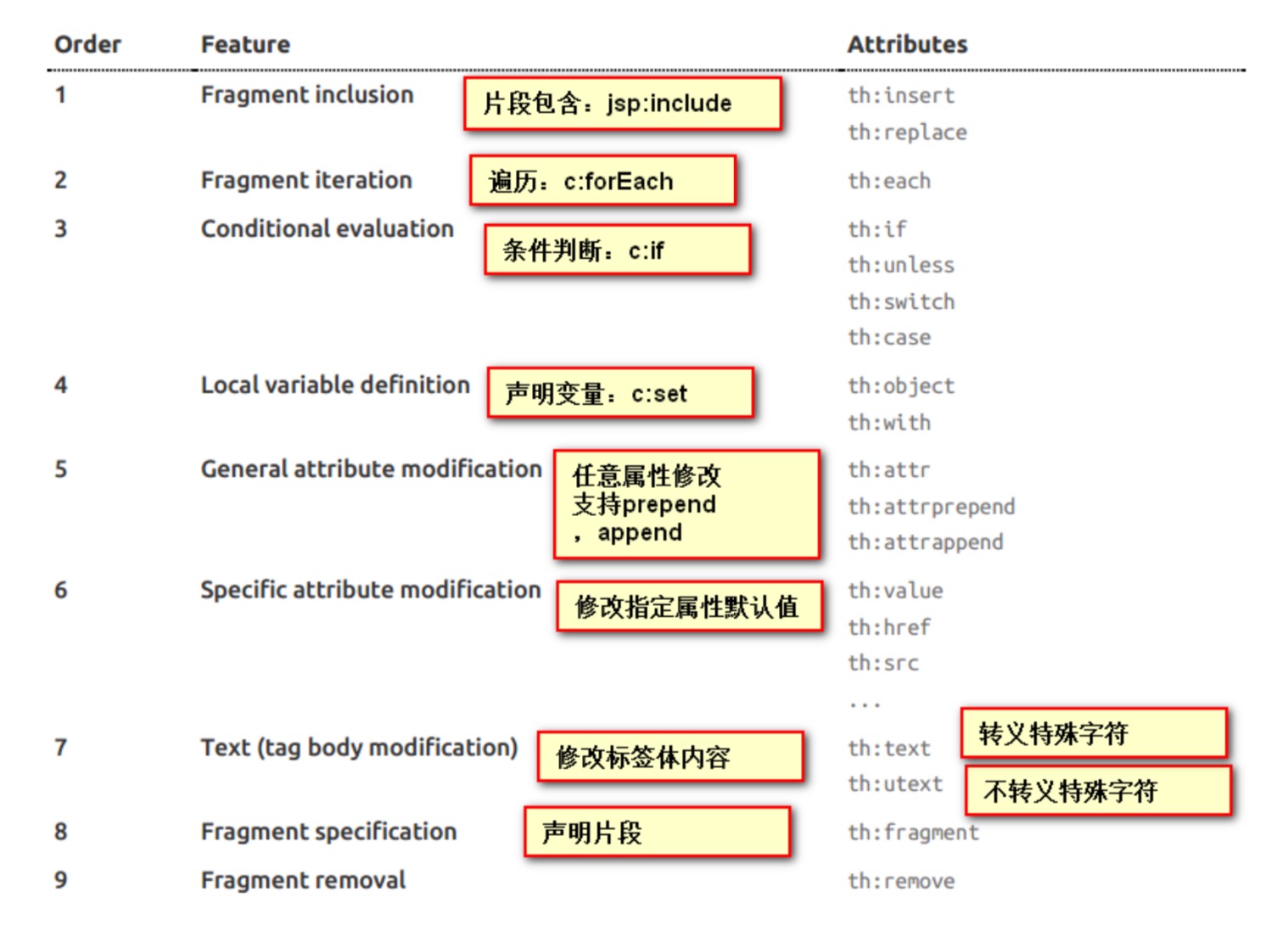---恢复内容开始---
模板引擎的思想
模板是为了将显示与数据分离,模板技术多种多样,但其本质都是将模板文件和数据通过模板引擎生成最终的HTML代码。

Thymeleaf介绍
Thymeleaf是适用于Web和独立环境的现代服务器端Java模板引擎。
Thymeleaf的主要目标是为您的开发工作流程带来优雅的自然模板 -HTML可以在浏览器中正确显示,也可以作为静态原型工作,从而可以在开发团队中加强协作。
Thymeleaf拥有适用于Spring Framework的模块,与您喜欢的工具的大量集成以及插入您自己的功能的能力,对于现代HTML5 JVM Web开发而言,Thymeleaf是理想的选择-尽管它还有很多工作要做。
Thymeleaf使用
1、新建一个SpringBoot项目,并且引入thymeleaf依赖
1 <dependency> 2 <groupId>org.springframework.boot</groupId> 3 <artifactId>spring-boot-starter-thymeleaf</artifactId> 4 </dependency>
最终pom文件如下:

1 <?xml version="1.0" encoding="UTF-8"?> 2 <project xmlns="http://maven.apache.org/POM/4.0.0" 3 xmlns:xsi="http://www.w3.org/2001/XMLSchema-instance" 4 xsi:schemaLocation="http://maven.apache.org/POM/4.0.0 http://maven.apache.org/xsd/maven-4.0.0.xsd"> 5 <modelVersion>4.0.0</modelVersion> 6 7 <groupId>com.test</groupId> 8 <artifactId>test-springboot-web</artifactId> 9 <version>1.0-SNAPSHOT</version> 10 11 12 <parent> 13 <groupId>org.springframework.boot</groupId> 14 <artifactId>spring-boot-starter-parent</artifactId> 15 <version>2.1.8.RELEASE</version> 16 </parent> 17 18 <properties> 19 20 <project.build.sourceEncoding>UTF-8</project.build.sourceEncoding> 21 <project.reporting.outputEncoding>UTF-8</project.reporting.outputEncoding> 22 <java.version>1.8</java.version> 23 </properties> 24 25 <dependencies> 26 <dependency> 27 <groupId>org.springframework.boot</groupId> 28 <artifactId>spring-boot-starter-web</artifactId> 29 </dependency> 30 31 <dependency> 32 <groupId>org.springframework.boot</groupId> 33 <artifactId>spring-boot-starter-thymeleaf</artifactId> 34 </dependency> 35 36 <dependency> 37 <groupId>org.springframework.boot</groupId> 38 <artifactId>spring-boot-starter-test</artifactId> 39 <scope>test</scope> 40 </dependency> 41 42 </dependencies> 43 44 45 <!-- SpringBoot打包插件,可以将代码打包成一个可执行的jar包 --> 46 <build> 47 <plugins> 48 <plugin> 49 <groupId>org.springframework.boot</groupId> 50 <artifactId>spring-boot-maven-plugin</artifactId> 51 </plugin> 52 </plugins> 53 </build> 54 </project>
2、编写controller,在controller中将数据绑定到页面(success.html)
1 package com.test.springboot.web.controller; 2 3 import org.springframework.stereotype.Controller; 4 import org.springframework.web.bind.annotation.RequestMapping; 5 import org.springframework.web.bind.annotation.ResponseBody; 6 7 import java.util.Arrays; 8 import java.util.Map; 9 10 @Controller 11 public class HelloController { 12 13 @RequestMapping("/success") 14 public String success(Map<String, Object> map){ 15 map.put("hello", "<span style="color: red;">hello!</span>"); 16 map.put("users", Arrays.asList("张三", "李四", "王五")); 17 return "success"; 18 } 19 20 }
3、编辑页面resources/templates/success.html,在页面上获取数据
1 <!DOCTYPE html> 2 <!-- 3 xmlns:th="http://www.thymeleaf.org" 的作用是增加thymeleaf的语法提示 4 --> 5 <html lang="en" xmlns:th="http://www.thymeleaf.org"> 6 <head> 7 <meta charset="UTF-8"> 8 <title>Title</title> 9 </head> 10 <body> 11 test page 12 <h4 th:text="${hello}"></h4> 13 <h4 th:utext="${hello}"></h4> 14 <h4 th:each="user:${users}" > [[${user}]] </h4> 15 </body> 16 </html>
4、重启项目,在浏览器中使用地址 :http://localhost:8080/success,进行访问,效果如下

小技巧:springboot上修改thymeleaf页面,想要不重启项目就生效,需要做2点
1、关闭thymeleaf的缓存 ,在属性文件中设置:spring.thymeleaf.cache=false ,默认是开启的
2、ctrl + F9 重新编译界面
Thymeleaf语法
1、获取变量值
a、行内表达式 [[...]] or [(...)]
在Thymeleaf中,[[...]]或之间的表达式[(...)]被认为是内联表达式,在它们内部,我们可以使用在th:text 或 th:utext属性中也有效的任何类型的表达式。
[[...]]:表示th:text,会转义特殊字符
[(...)]:表示th:utext,不会转义特殊字符
1 Hello, [[${session.user.name}]]!
b、变量表达式 ${…}
使用方法:直接使用th:xx="${}" 获取对象属性,通过${…}进行取值,这点和ONGL表达式语法一致!
1 <p>Today is: <span th:text="${today}">13 february 2011</span>.</p>
c、选择变量表达式 *{...}
使用方法:首先通过 th:object 获取对象,然后使用th:xx = "*{}"获取对象属性
1 <div th:object="${session.user}"> 2 <p>Name: <span th:text="*{firstName}">Sebastian</span>.</p> 3 <p>Surname: <span th:text="*{lastName}">Pepper</span>.</p> 4 <p>Nationality: <span th:text="*{nationality}">Saturn</span>.</p> 5 </div>
d、消息表达
即通常的国际化属性:#{msg} 用于获取国际化语言翻译值
1 <title th:text="#{user.title}"></title>
e、链接表达式
使用方法:通过链接表达式@{}直接拿到应用路径,然后拼接静态资源路径。
1 <script th:src="@{/webjars/jquery/jquery.js}"></script> 2 <link th:href="@{/webjars/bootstrap/css/bootstrap.css}" rel="stylesheet" type="text/css">
f、片段表达式
片段表达式是Thymeleaf的特色之一,细粒度可以达到标签级别,这是JSP无法做到的。片段表达式拥有三种语法
~{ viewName } 表示引入完整页面~{ viewName ::selector} 表示在指定页面寻找片段 其中selector可为片段名、jquery选择器等~{ ::selector} 表示在当前页寻找
1 <div th:insert="~{commons :: main}">...</div>
g、其他表达式
在基础语法中,默认支持字符串连接、数学运算、布尔逻辑和三目运算等。
1 <input name="name" th:value="${'I am '+(user.name!=null?user.name:'NoBody')}"/>
2、设置标签属性
th:text;改变当前元素里面的文本内容;
th:任意html属性;来替换原生属性的值

3、常用的内置对象
一、ctx :上下文对象。
二、vars :上下文变量。
三、locale:上下文的语言环境。
四、request:(仅在web上下文)的 HttpServletRequest 对象。
五、response:(仅在web上下文)的 HttpServletResponse 对象。
六、session:(仅在web上下文)的 HttpSession 对象。
七、servletContext:(仅在web上下文)的 ServletContext 对象
4、常用的内置方法
一、strings:字符串格式化方法,常用的Java方法它都有。比如:equals,equalsIgnoreCase,length,trim,toUpperCase,toLowerCase,indexOf,substring,replace,startsWith,endsWith,contains,containsIgnoreCase等
二、numbers:数值格式化方法,常用的方法有:formatDecimal等
三、bools:布尔方法,常用的方法有:isTrue,isFalse等
四、arrays:数组方法,常用的方法有:toArray,length,isEmpty,contains,containsAll等
五、lists,sets:集合方法,常用的方法有:toList,size,isEmpty,contains,containsAll,sort等
六、maps:对象方法,常用的方法有:size,isEmpty,containsKey,containsValue等
七、dates:日期方法,常用的方法有:format,year,month,hour,createNow等
5、迭代循环
想要遍历List集合很简单,配合th:each 即可快速完成迭代。例如遍历用户列表:
1 <div th:each="user:${userList}"> 2 账号:<input th:value="${user.username}"/> 3 密码:<input th:value="${user.password}"/> 4 </div>
集合的迭代过程还可以获取状态变量,只需在变量后面指定状态变量名即可,状态变量可用于获取集合的下标/序号、总数、是否为单数/偶数行、是否为第一个/最后一个。
1 <div th:each="user,stat:${userList}" th:class="${stat.even}?'even':'odd'"> 2 下标:<input th:value="${stat.index}"/> 3 序号:<input th:value="${stat.count}"/> 4 账号:<input th:value="${user.username}"/> 5 密码:<input th:value="${user.password}"/> 6 </div>
xxStat, 例如:
1 <div th:each="user:${userList}" th:class="${userStat.even}?'even':'odd'"> 2 下标:<input th:value="${userStat.index}"/> 3 序号:<input th:value="${userStat.count}"/> 4 账号:<input th:value="${user.username}"/> 5 密码:<input th:value="${user.password}"/> 6 </div>
